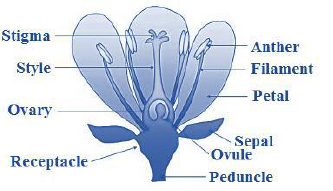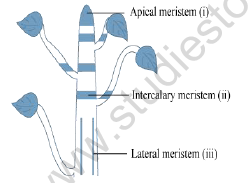Morphology (Gr. Morphos = Form; logos = Study) is the branch of science which deals with the study of form and structure. In botany, it generally means the study of external features, forms and relative positions of different organs on plants.
Angiospermic or flowering plants show a great variety of shape, size and form. The size ranges from the minuteWolffia and Lamna (0.1cm) to the tall Eucalyptus (up to 100 metre) and large sized Banyan (Ficus bengalensis).
The root is usually an underground part of the plant which helps in fixation and absorption of water. The root with its branches is known as the root system.
(1) Characteristics of the root
(i) The root is the descending portion of the plant axis and is positively geotropic.
(ii) It is non-green or brown in colour.
(iii)The root is not differentiated into nodes and internodes.
(iv) As per the rule the root does not bear leaves and true buds.
(v) Usually the root tip is protected by a root cap.
(vi) The root bears unicellular root hairs.
(vii) Lateral roots arise from the root which are endogenous in origin (arises from pericycle).
(2) Types of root system:
The root system is generally of two types:
(i) Tap root system: The tap root system develops from radicle of the germinating seed. It is also called the normal root system. The tap root system is present in dicotyledonous plants.
(ii) Adventitious root system: The root system that develops from any part of the plant body other than the radicle is called the adventitious root system. It is mostly seen in monocotyledonous plants.
The Stem
(1) The stem develops from the plumule of the germinating seed.
(2) The stem shows the differentiation of nodes and internodes.
(3) The place where the leaf develops on the stem is called the node.
(4) The portion of the stem between two successive nodes is called the internode.
(5) Characteristics of stem
(i) Stem is an ascending axis of the plant and develops from the plumule and epicotyl of the embryo.
(ii) It is generally erect and grows away from the soil towards light. Therefore, it is negatively geotropic and positively phototropic.
(iii) The growing apex of stem bears a terminal bud for growth in length.
(iv) In flowering plants, stem is differentiated into nodes and internodes.
(v) The lateral organs of stem (i.e., leaves and branches) are exogenous in origin (from cortical region).
(vi) The young stem is green and photosynthetic.
(vii) Hair, if present, are generally multicellular.
(viii) In mature plants, stem and its branches bear flowers and fruits.
The Leaf
The leaf is a green, flat, thin, expanded lateral appendage of stem which is borne at a node and bears a bud in its axil. It is exogenous in origin and develops from the leaf primordium of shoot apex. The green colour of leaf is due to presence of the photosynthetic pigment – chlorophyll which helps plants to synthesize organic food. The green photosynthetic leaves of a plant are collectively called foliage. They are borne on stem in acropetal succession.
(1) Characteristics of lea
(i) The leaf is a lateral dissimilar appendage of the stem.
(ii) A leaf is always borne at the node of stem.
(iii) Generally there is always an axillary bud in the axil of a leaf.
(iv) It is exogenous in origin and develops from the swollen leaf primordium of the growing apex.
(v) The growth of leaf is limited.
(vi) The leaves do not possess any apical bud or a regular growing point.
(vii) A leaf has three main parts – Leaf base, petiole and leaf lamina. In addition, it may possess two lateral outgrowths of the leaf base, called stipules.
(viii) The leaf lamina is traversed by prominent vascular strands, called veins.
Flower
It can be defined as modified dwarf shoot which is meant for sexual reproduction.
(1) Floral Parts of a typical flower:
(i) Calyx: It is the outermost whorl composed ofsepals. The calyx may show number of modifications. They are:
Campanulate : Bell shaped, e.g., Althaea.
Cupulate : Cup like, e.g., Gossypium.Petaloid : Enlarged and brightly coloured sepals,e.g., Clerodendron, Mussaenda

(ii) Corolla: It is composed of petals and is the second whorl.
The corolla may undergo modifications or possess some special appendages.
(a) Sepaloid : Green or dull coloured sepal. e.g., Anona, Polyalthia and Artabotrys.
(b) Saccate : The corolla tube may form a pouch on one side. e.g., Antirrhinum.
(c) Spurred : Sometimes one or two petals or the entire corolla tube grow downwards forming a spur that usually stores nectar. e.g., Aquilegia vulgaris.
(d) Corona : Special appendages of different kinds like scales, hairs develop from the corolla.
Such appendages are called corona. e.g., Passiflora, Oleander and Nerium.
(iii) Androecium: It is the third whorl composed of stamens.
The mode of attachment of a filament to anther by connective is called fixation. It is of following types:
(a) Adnate : Filament attached to the total length of the anther on the back. e.g., Michelia (Campa).
(b) Basifixed : Filament is attached to the base of the anther e.g.,...
ANATOMY
A tissue may be defined as, “a group of similar or dissimilar cells having common origin and performing a specific functions.”
Tissues are mainly divided into three categories:
(A) Meristematic tissues or Meristems
(B) Permanent tissue
(C) Secretory tissue
Meristematic Tissues or Meristems
(1) They contain immature and young cells and are capable of repeated divisions.
(2) Intercellular spaces are not present in meristematic tissue.
(3) They contain a homogeneous thin wall.
(4) They contain large nuclei associated with abundant cytoplasm.
(5) They are metabolically very active but they do not store food material.
(6) Only proto-plastids are present instead of plastids, chloroplast absent.
(7) Dense cytoplasm is present which contains several premature mitochondria.
(8) Vacuoles are absent.
(9) Meristematic cells are isodiametric in shape.
Types of meristems
The meristems may be classified on the basis of their mode of origin, position or function:
(i) According to origin and development: On the basis of origin, meristematic tissues are of three types :
(a) Promeristem or Primordial meristem: The promeristem originates from embryo and, therefore, called primordial or embryonic meristem. It is present in the regions where an organ or a part of plant body is initiated.
(b) Primary meristem: A primary meristem originates from promeristem and retains its meristematic activity. It is located in the apices of roots, stems and the leaf primordia.
(c) Secondary Meristem: They always arise in permanent tissues and have no typical promeristem. Some living permanent cells may regain the meristematic nature.
(ii) According to position: On the basis of their position in the plant body meristems are classified into three categories:

(a) Apical meristem: This meristem is located at the growing apices of main and lateral shoots and roots. These cells are responsible for linear growth of an organ.
(b) Intercalary meristem: These are the portions of apical meristems which are separated from the apex during the growth of axis and formation of permanent tissues. It is present mostly at the base of node (e.g., Mentha viridis-Mint), base of internode (e.g., stem of many monocots viz., Wheat, Grasses, Pteridophyts like Equisetum) or at the base of the leaf (e.g., Pinus).
(c) Lateral meristem: These meristems occur laterally in the axis, parallel to the sides of stems and roots. This meristem consists of initials which divide mainly in one plane (periclinal) and result increase in the diameter of an organ.
Please click the link below to download pdf file of NEET Biology Morphology and Anatomy of Flowering Plant Revision Notes

